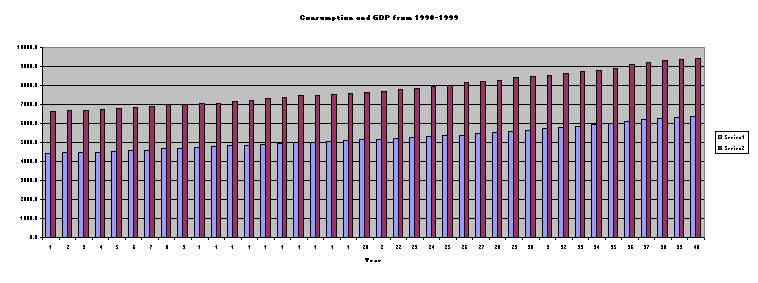ALISON ADAMS
College of Business
Western Carolina University
Abstract
Consumption expenditures are forecast to grow approximately 1.5% in
2001 and 2002.The consumption
forecast is based on the fact that consumption is a variable of GDP.This
approach is based on the Keynesian Consumption Function.GDP
is the sum of consumption, investment, government spending, and net exports.Consumption
spending is a function of real income, measured as real GDP.(JEL:
E21, E120)
Part 1.Introduction
This paper forecasts
personal consumption in the years 2001 and 2002.U.S.
Gross domestic product (GDP) is the explanatory variable that will predict
consumption in the future.Consumption
is one of several variables that affect GDP.This
approach is based on the Keynesian aggregate expenditure model. This model
will be used because it is useful for macroeconomic forecasting and policy
analysis, as well as its correspondence to the National Income and Product
Accounts (NIPA). Nominal aggregate expenditure equals GDP over any time
period, which is the sum of consumption, investment, government spending,
and net exports.
The rest of this
paper is organized as follows:Part
2. presents the data used to forecast consumption; part 3. explains the
theoretical basis for the approach adopted in forecasting consumption;
Part 4. presents forecasts of consumption for 2001 and 2002; Part 5. evaluates
the importance of the forecast for the economy; and Part 6. discusses conclusions
for economic policy.
Part 2. Data
The first variable
is consumption.This data is retrieved
from the Federal Reserve Bank of St. Louis Federal Reserve Economic Data
(FRED).The FRED descriptor is PCECC96.The
figures used for the sample period are in billions of chained 1996 U.S.
dollars and is observed quarterly.The
explanatory variable is real GDP.The
FRED descriptor for GDP is GDPC96.The
figures used for the sample period are seasonally adjusted in chained 1996
U.S. dollars and is observed quarterly.This
information is gathered from FRED because it is very reliable and readily
available for all persons.
Chart 1

Part 3.The
Keynesian Consumption Function
Consumption consists of autonomous consumption and induced consumption.Autonomous consumption does not depend on real GDP or disposable income.Induced consumption is dependent of both real GDP and disposable income.The intercept of the consumption function is autonomous consumption, and the slope of the consumption function is the marginal propensity to consume (MPC).Marginal propensity to consume relates to the thought of the more income people have, the more they are willing to spend on consumption (Keynes is a believer in this statement).“Keynes suggested that there was a ‘psychological law’ that any increase in income would result in and increase in consumption, but that the increase in consumption would be in less that a one-to-one proportion” (Income and Consumption).Consumption will increase by a small proportion of income when income increases by a dollar. This fraction is the marginal propensity to consume.The consumption function can be written as:
C = Co + MPC x Y
Where Co is autonomous consumption, (MPC * Y) is induced consumption, and Y is real GDP.Lagging the right hand side of the consumption function by two years provides the following forecasting equation:
C = Co + C1 x Yt-2
Part 4. Empirical Results
The r-square is .9957.This
means that 99.57% of variation in consumption is related to GDP.The
t-statistics of the intercept is low, which shows low rejection of the
null hypotheses.On the other hand,
the t-statistics for GDP is very high, showing high rejection.Table
1 shows the regression summary.
|
Regression Estimate of Consumption Forecasting
Equation:1991.1-2000.4 |
||
|
|
|
|
|
Intercept
|
|
|
|
GDP
|
|
|
|
R Square = .9995673
|
Multiple R = .997834
|
|
This forecasts shows
that consumption will decrease in the first quarter of 2000, but then begin
increasing again.I believe the forecasted
data resembles data from the past.This
could be due to consumers saving their money due to a scare of inflation.Induced
consumption depends on disposable income, so if disposable income decreases,
consumption will also decrease.This
is assuming that consumption expenditures are depending on total real income
and could be a theory of what will happen in the future.Table
2 gives the forecast results.
|
Forecast of Consumption for 2001 and 2002 |
||
| Year/Quarter |
|
|
|
|
|
|
|
|
|
|
|
|
|
|
|
|
|
|
|
|
|
|
|
|
|
|
|
|
|
|
|
|
|
|
This forecasts shows that there will be very little change in consumption based on GDP, except for in the first quarter of 2001.If there is an increase in consumption spending, there could also be an increase in output price, causing inflation. Inflation can occur from consumption increasing, and unemployment could fall under the natural rate of employment.The more that consumers are spending, the less they are saving.The government appreciates the lack of saving because the more consumers spend, the more the government can earn on tax dollars.When there is a lack of saving, there is an increase in consumption.